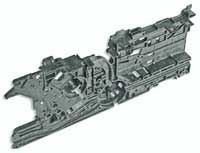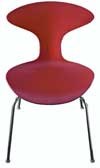Specialty Thermoplastic Compounds Push the Envelope in All Directions
At least eight new developments are pushing specialty thermoplastic compounds into higher levels of performance and opening up new areas of potential applications.
At least eight new developments are pushing specialty thermoplastic compounds into higher levels of performance and opening up new areas of potential applications. These advances come from the R&D labs at the former LNP Engineering Plastics, Exton, Pa., which has now been folded into GE Advanced Materials, Plastics.As explained by Charlie Crew, president of LNP Products, LNP is now a brand name and a business group within GE—as is, for example, Lexan polycarbonate.
GE’s ambitious plans for LNP Products are supported by a $2.9-million investment in the newly expanded Technology Innovation Center at Exton, which has 11,700 sq ft dedicated to R&D on lubricated, flame-retardant, conductive, and other specialty compounds. The new Center has an open bay and a closed bay for handling conductive additives like carbon black. It also now has three twin-screw extruders and a Buss kneader, as well as two electric and two hydraulic injection ma chines and extensive laboratory testing capabilities.
Brand-new effects
Among several exciting projects still in early development, one is for “ controlled-release” internal lubrication of plastics. As explained by product development manager Ann Bolvari, the goal is to provide internal lubrication while maximizing mechanical properties. Various means being explored involve incorporating additives in an inert form that does not harm properties, but which releases its lubricating function only at the site of mechanical wearing action and only when that action occurs.
Another novel ef fect being developed, Bolvari says, is plastics with a “positive temperature coefficient.” They would contain an electrically conductive additive that turns the plastic component into a resistance heater. However, the additive would act as a built-in thermostat, losing its conductivity when the part reaches a certain temperature, cutting off further heating. Then, when the part cools to a certain temperature, the conductivity would return, thereby maintaining the part temperature within a given range. Potential applications include diesel engine preheaters, auto mirror housings (to dispel fogging), and even electric blankets.
Pushing the envelope
Bolvari also reports work on LNP Konduit compounds with improved thermal conductivity for uses such as disk-drive actuators. Through-plane conductivity of these compounds has been raised from the previous limit of 1.5 W/mK to 2.5 W/mK, a 66% increase. Bolvari says the long-term goal is to achieve 10 W/mK (through-plane), but that will require new additives and take several years.
There’s also work afoot to boost structural properties of engineering compounds. Bolvari says GE/LNP is developing a thin-wall (0.8-mm) polycarbonate compound for a laptop computer case. The goals are to provide high strength and modulus (around 2.5 million psi) together with a non-halogen flame-retardant system. The firm also seeks to replace the magnesium sheet behind the laptop LCD with a compound having 5 million psi modulus. Both compounds will utilize LNP Verton long-fiber technology. GE expected to announce the results of this project last month.
Conductive & antistatic
Two new commercial products address markets for electrically conductive and antistatic compounds—a traditional LNP specialty. At the antistatic end of the range, new LNP Stat-Loy PCA FR 94 V-0 compound is based on GE’s Cycoloy PC/ABS. It combines high toughness with rapid electrostatic decay (less than 2 sec), custom colorability, and UL 94V-0 flame resistance at 1.5 mm. It boasts surface resistivity of 1011 ohm/sq, no sloughing, and notched Izod impact of 12 ft-lb/in.
For a higher level of conductivity, new LNP Faradex DS-1003 FR HI provides EMI/RFI shielding plus high impact and high flow. Based on stainless-steel fibers and Lexan EXL silicone rubber-modified polycarbonate, the product boasts EMI attenuation of 20 to 60 dB together with a reportedly unique level of toughness for such a compound—9 kJ/m2 at -45 C. It also meets UL 94V-0 at 2.1 mm without halogen.
New long-fiber compounds
While polypropylene and nylon have been the mainstays of LNP Verton long-fiber technology, new resin matrixes are now being commercialized. One is PBT long-glass compounds in the LNP Verton WF series. Examples are WF-7007 with 35% long glass and WF-700-10 with 50% long glass. According to Nitin Apte, global product manager for LNP products, PBT confers better moisture resistance, dimensional stability, and uv resistance than nylon, though nylon has slightly higher strength and modulus. LNP Verton WF is aimed at automotive connectors and other electrical and consumer products.
Also new is the LNP Verton PCA series, based on PC/ABS. This is the first amorphous-based LNP Verton compound. Its first commercial use is the Orbit stacking chair from Bernhardt Design, Lenoir, N.C., injection molded with gas assist by Mack Molding, Arlington, Vt. This material, which contains only 20% long glass, was chosen because it provides high flow, good dimensional stability, and a resin-rich surface that is paintable without priming. Its flex modulus is 1.01 million psi, notched Izod impact is 3.3 ft-lb/in., and unnotched Izod is 10.7 ft-lb/in.
Non-halogen FR compounds
A new series of flame-retardant nylon compounds that meet upcoming European Union regulations for end-of-life product disposal is being introduced to the U.S. LNP Starflam XGen compounds are based on nylon 6, 66, and 6/66 copolymers. Six new grades contain 20% to 45% short glass and no halogen or red phosphorus. They offer UL 94 V-0 at 0.8 mm, previously only available with halogen formulations. They also have flex moduli up to 12.5 Gpa (1.812 million psi) and tensile strengths up to 170 Mpa (25,000 psi) plus good impact strength and CTI of 600 V. They are also colorable and laser markable, and their densities (1.36 to 1.58 g/cc) are lower than those of brominated and red-phosphorus compounds.
Related Content
Research Suggests Path From Waste Plastics to High Value Composites
Flash joule heating could enable upcycling of waste plastic to carbon nanomaterials.
Read MoreRead Next
Understanding Melting in Single-Screw Extruders
You can better visualize the melting process by “flipping” the observation point so that the barrel appears to be turning clockwise around a stationary screw.
Read MorePeople 4.0 – How to Get Buy-In from Your Staff for Industry 4.0 Systems
Implementing a production monitoring system as the foundation of a ‘smart factory’ is about integrating people with new technology as much as it is about integrating machines and computers. Here are tips from a company that has gone through the process.
Read MoreWhy (and What) You Need to Dry
Other than polyolefins, almost every other polymer exhibits some level of polarity and therefore can absorb a certain amount of moisture from the atmosphere. Here’s a look at some of these materials, and what needs to be done to dry them.
Read More













.png;maxWidth=300;quality=90)













